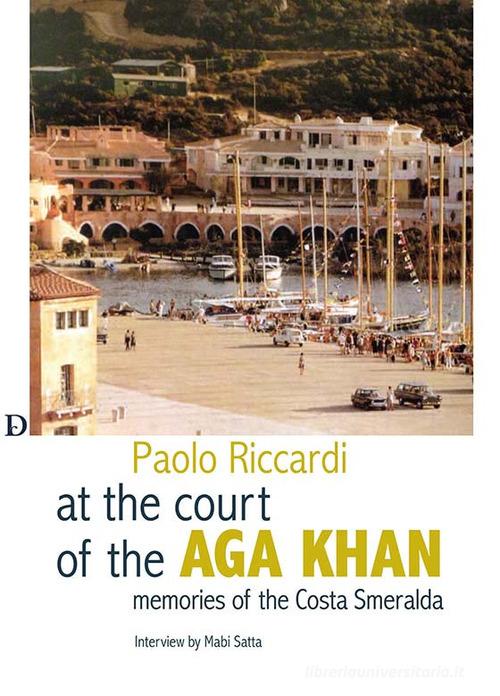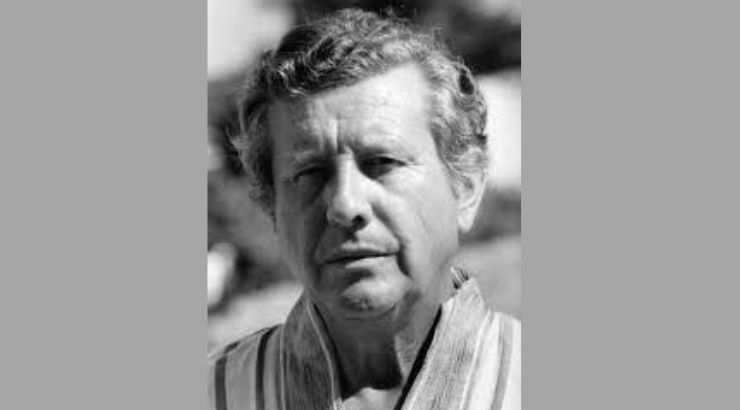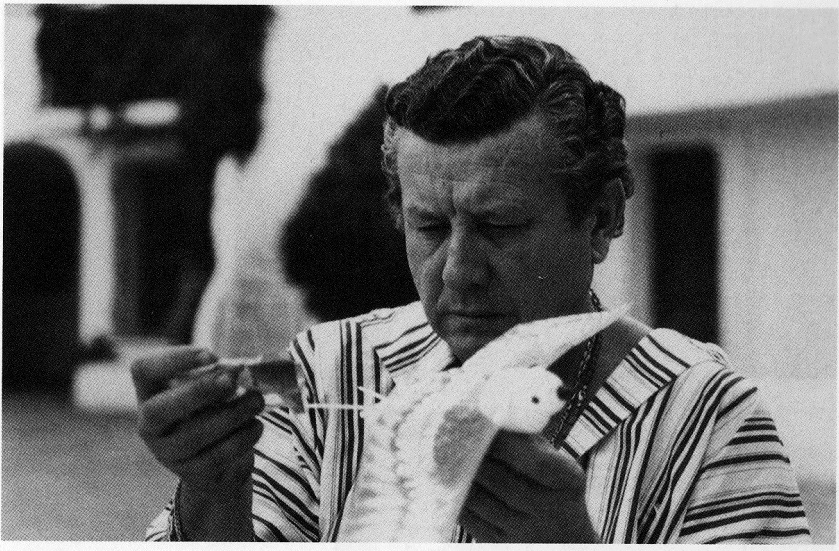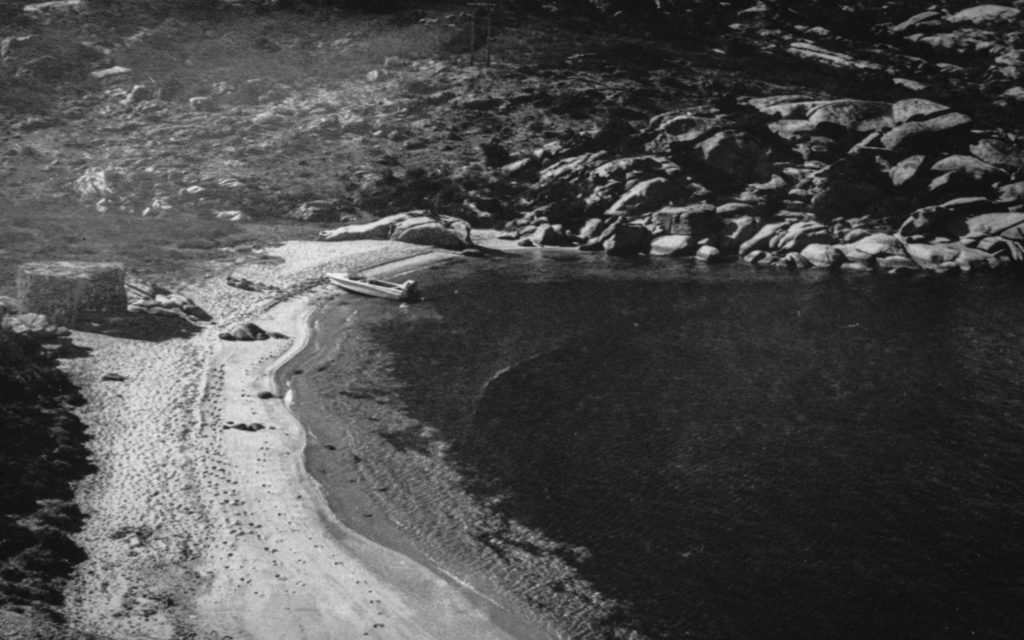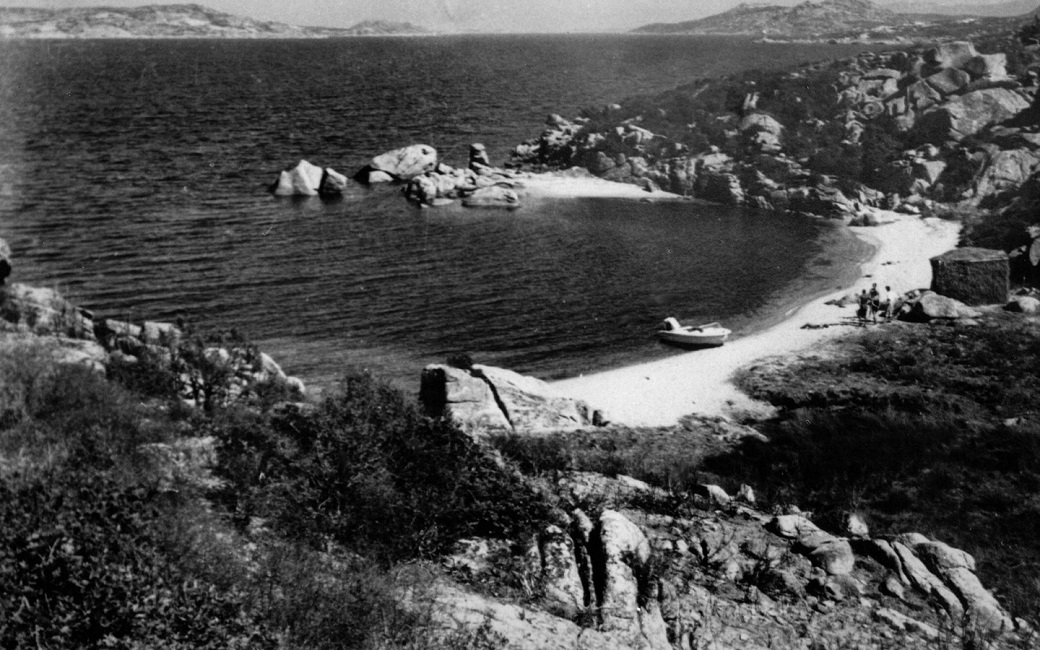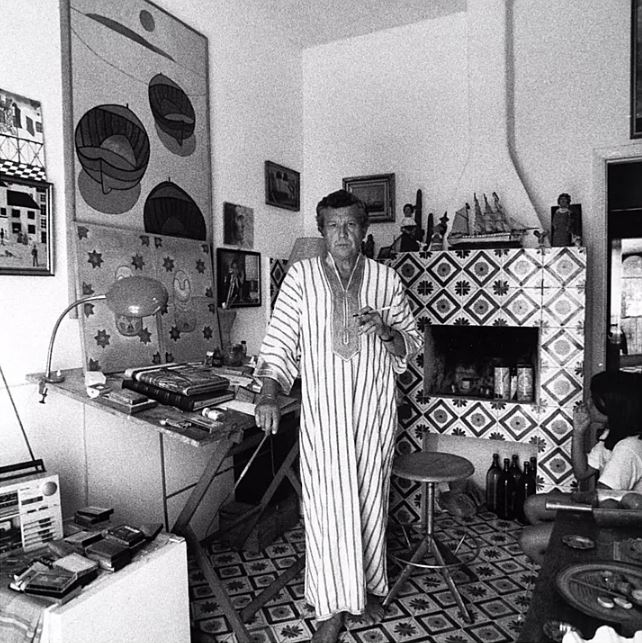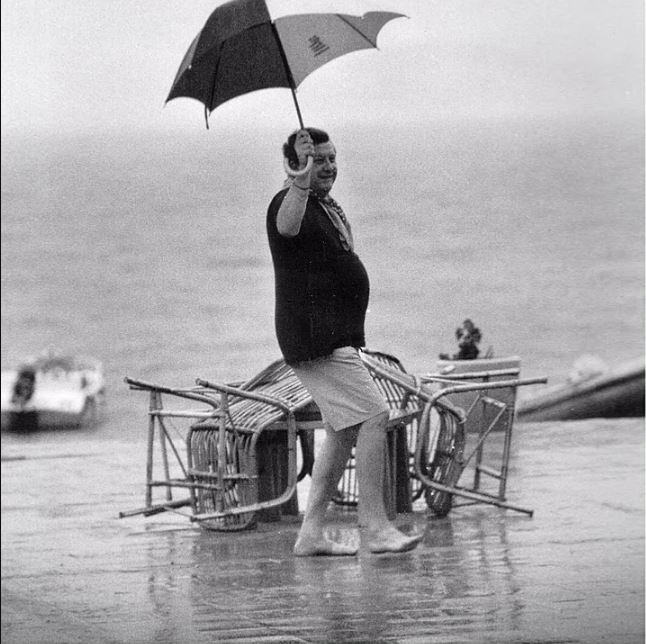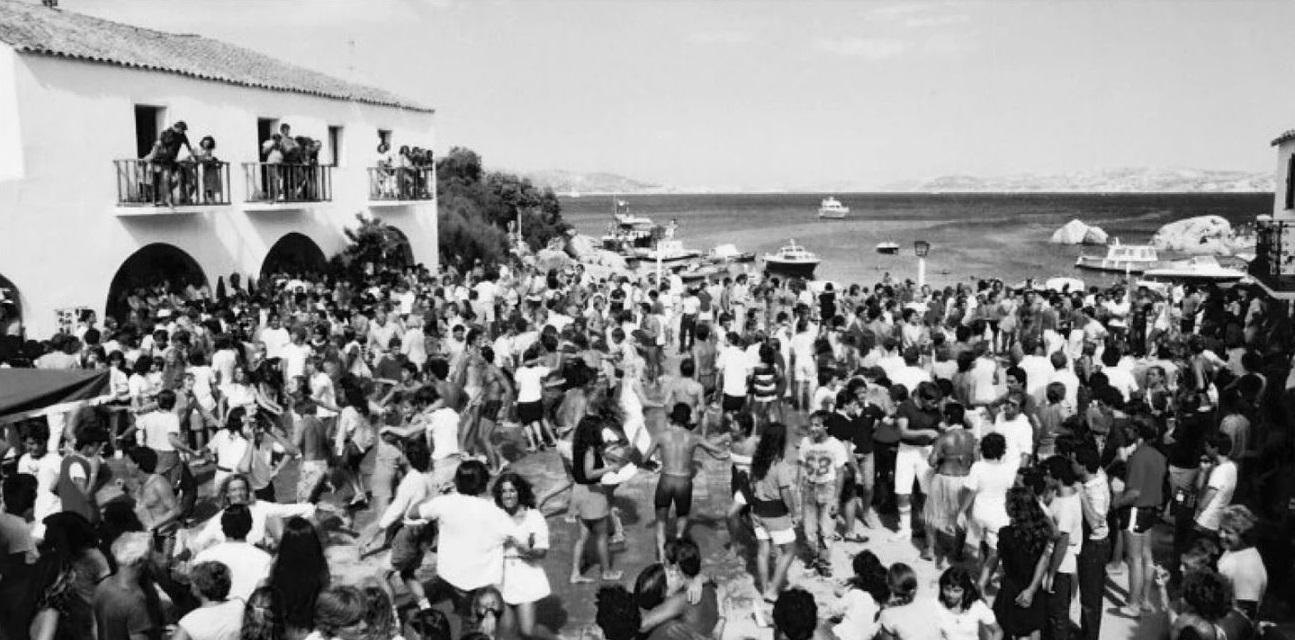RAFAEL NEVILLE
PORTO RAFAEL
taken from the book
AT THE COURT OF AGA KHAN
MEMORIES OF THE COSTA SMERALDA
by PAOLO RICCARDI
Interview by Mabi Satta
SEE HERE ⇒
With the kind permission of the publisher Carlo Delfino, we are publishing an extensive excerpt from the book
HIDALGO DI NOME RAPHAEL
[PRIMA DELL’AGA KHAN E DELLA COSTA SMERALDA. RAPHAEL NEVILLE e DINO DA PONTE]
Before the Aga Khan [and The Costa Smeralda. Raphael Neville e Dino Da Ponte]
This first part of the story tells of the foundation of Porto Raphael in which Paolo Riccardi had played a significant role, which we find both interesting and amusing to record. Those readers anxious to begin with the Costa Smeralda story, may go directly to Chapter 2: At the Court of the Aga Khan
Paolo Riccadi begins telling his story: It all begins in 1959, when as yet there was no Aga Khan, in the sense that he had not yet come to Sardinia (he arrived in 1961). I, instead, had begun to deal with the great touristic potential of Sardinia two years earlier, in 1959. That was when Raphael Neville showed up in my office in Sassari, with a letter from professor Sergio Costa, the rector of the University.
The story, then, begins in Sassari – we start with Raphael’s entrance into my office.
That year, 1959, the Spanish ambassador in Rome sent a letter to Professor Sergio Costa that said: «I would like to introduce you to Raphael Neville, son of the famous Edgar Neville, count of Berlanga and Duero.» And the professor sent him to me.
Edgar Neville, a great writer, movie-maker, and producer, was a prominent figure in Spain. He had been ambassador to Washington. Raphael had inherited his sumptuous presence, albeit interpreted with a hippy-pop flair.
When he walked into my studio, Raphael was 32 years old. My secretary knocks and says «Mr. Riccardi, there’s a very odd fellow here who has given me this letter for you.» He had come with a miniscule dog tucked into a pocket of his jacket, and a basket like those used by countrywomen to gather figs or fruit, thick blue glasses, and a short leather bolero vest. Never had I seen anyone in a similar get-up. A high-class “fruitcake,” but a fruitcake nonetheless.
Raphael begins speaking in French. Fortunately, I had studied French and could follow him relatively well: «I dreamed of this place, in the heart of the Mediterranean, of a beach where I want to build a village.». «Well then. And when did you dream of it??». «Even when I am awake I am always dreaming of this beach!». «Very good, and as this apparition has so possessed you, what can I do for you?»
«I’ve gone all over Corsica and I haven’t found the beach I dreamed of, so it has to be here in Sardinia.» «Ah, good idea. And what should I do then?» «Well, you see what you can do, give me some pointers. Help me to find my beach.». Given he had been presented to me, I could hardly respond «Go look for your beach alone, across the whole of Sardinia.» So I say: «Look, tomorrow I’m free, so we can go to Stintino» (where I spend my holidays).
The beauty of Pelosa was one of a kind. There were no buildings, nothing. I take him in my car. He looks at all of the beaches. «No, this isn’t the beach. No, neither is this.» I start to get annoyed. We lunch at Silvestrino, a famous restaurant in Stintino. We feast on lobster. He was a great lover of lobster and fish. Then we drink, in industrial quantities. When we are about to return to Sassari, I’m passing in front of the little port to show it to him, and I notice someone at my cousin’s house, Gigetto Pinelli, a doctor known throughout Sassari. A delightful person. I knock: «Oh, Paolo!». Hugs and kisses all around. «Let me introduce you to my Spanish friend Raphael…». As he is from Alghero (where Catalan is spoken) he begins: «Hasta la vista! What will you have?» And I: «A Sardinian vernaccia, the Zinnarosu of Milis». Because I know that this Zinnarosu is a client of Gigetto’s and that every time he comes to Sassari he brings an extraordinary vernaccia with him, one he makes himself. «And why not? That’s just what I was about to offer you.». We start drinking, savoring this amazing ambrosia. We must have had four or five glasses apiece. Gigetto, addressing me in the Sassarese dialect so as not to be understood by Raphael, comments: «A chistu lu imbriaghemmu» (“We’ll get this one drunk”). Raphael was a prodigious drinker. He would start in the morning with aperitifs and continue until the wee hours, stopping just before going to bed, as dawn was approaching. I never once saw him even totter. That afternoon it was Gigetto who ended up tremendously drunk. Raphael and I put him to bed and I left him a note: «Gige’, it seems to me it’s the Spaniard who has gotten you drunk.»
The beach of his dreams
And we were off again. In the morning I take him to Alghero. I show him the beaches of the Bombarde and all the others, from Tramariglio to Porto Ferro. «No, this isn’t the one I dreamed about.». We drop the use of the formal you in Italian: «So, Paolo, where do you reckon I’ll find the beach from my dreams?” «Raphael, they say that the beaches on the Maddalena archipelago are amazing. There are splendid islands in that area. But don’t go beyond Olbia, because that’s where the Nuorese begins, and that isn’t the right area. They are bright people, but a bit unusual! (they certainly had a unique pastime – it was in Nuorese where the hobby of Sardinian kidnapping was born!). Maybe you should go towards Cagliaritano. You might manage to find what you are looking for there.»
We head for the Maddalena archipelago in his car, a sort of miniature Jeep. Before leaving me, he announces: «I’ll be back in Sassari in a week». He disappears for two months. He reappears one morning when I’m in court. «Paolo, my dream has come true! I’ve found the beach I was looking for!». «Where?» «In Palau. I’ve bought three hectares of land for three million lire.» «You are completely out of your mind. You could have bought that land for two hundred thousand lire, and it would have been overpriced,» I inform him. «I’m fine with it. I’m leaving Porto Torres for Genoa and then I’m off to Nizza.»
An hour later, I receive a call from Porto Torres, and it’s the director of the “Tirrenia” ferry line on the phone: «Mr. Riccardi, there’s a bizarre fellow here, who says he is your client. He can’t leave because he hasn’t got 11,000 lire for a ticket.» I assure him that I’ll stop by in person the next day to give him 11,000 lire for the ticket. Thus, Raphael is able to leave.
He returned with the money to buy the land. That time, he was 500 thousand lire short, because in the meantime he had spent the money. He had set up a partnership with his sponsor, a beautiful Canadian actress named Shirley Douglas.
I helped Raphael to stipulate the contract to purchase the property, not least because the owners no longer wished to sell it to him and had been hoping to keep the deposit they had already received from him. I intervened and paid off the contract, supplying the 500 thousand lire needed for the transfer of property. First, though, I had a clause added which gave Raphael the option to buy other lots of land included in the 150 hectares owned by the seller. I reasoned: «Perhaps this way we’ll get back a lira or two,» which in fact he did, when in 1962 –on the mythical 15th of July – we signed the sale of the option of purchase on the remaining territory to the English banker of Romanian origin, Dino Da Ponte.
The calculations of the Romanian banker
Before buying the land, Da Ponte had wanted to meet me, as Raphael had told him to entrust himself to me, his personal friend.
Da Ponte came to Rome to meet me. He also, obviously, wanted an architect, Antonio Simon Mossa, from Sassari, a friend of mine as well as being one of the best known Sardinian architects. I invited him to the capital, along with Raphael, to meet the English banker. This was precisely the 15th of November, 1962.
The meeting was set at the Hotel Hassler. Da Ponte kept us for at least seven hours, asking us every possible piece of information on Sardinia: the cost of building, the state and regional laws regarding construction. Alongside him was his employee Casimir Stamirski, a Pole, who would later become president of the company and an inseparable friend of Raphael’s.
The next evening we leave for Sardinia. The sea is very rough, to the point that the bar and restaurant do not even open, for the idea of someone attempting to eat or drink is unthinkable. Nonetheless, Da Ponte and Stamirski make an urgent appeal to the captain to open the bar and restaurant, a request which he is in no position to refuse. For me it was a disastrous dinner. I was fortunate enough to avoid seasickness, though I have no idea how.
Once in Palau we chartered a small boat, because Da Ponte wanted to see the expanse of the land and its connecting beaches from the sea, from with what was called the “Bay of Nelson” or La Sciumara all the way down to Punta Sardegna.
Before disembarking he asks me: «Mr. Riccardi, do you advise me to purchase the property we are looking at?» I respond: «Do you want my precise opinion? (He had told me that should he buy the property, he would make me president of the company, a promise that he indeed maintained). Well then, I advise you to buy only the 30 hectares of the large beach, La Sciumara, which can be seen from the road which leads to Palau. As to the rest of it, with all these rocks – they are wild; it looks like Hell on Earth. What would you do with it all?». He scrutinizes my face and says: «Mr. Riccardi, I truly appreciate your sincerity, but you should remember that it is on those very rocks that I will make a pile of money.» With skepticism, I observe: «Lucky you, if you have a magic wand.» Imagine a Sardinian, used to going to Alghero and the Pelosa beach: all of those rocks, that mountainous landscape, were completely foreign to our way of thinking.
So, Da Ponte bought the 100 hectares that were to become Porto Raphael and named me the managing director of his Anglo-Italian company, Punta Sardegna. I stayed with them until June 1964. When I was hired by the Aga Khan, I was asked to leave the company of Da Ponte. This was partly because, in the meantime, Da Ponte had invited the aunt of the Aga Khan, Lady Cadogan (the maternal aunt of the Aga Khan) to spend a week at Porto Raphael. Upon her return from Porto Raphael to Porto Cervo, she complained to her nephew, «Ah, I have such fun at Porto Raphael, here it’s such a bore». From that moment on, the Aga Khan did not want to hear a single word about Porto Raphael.
In my role as administrator of this new company of Porto Raphael, I was informed of its investment plans. I immediately realized how important the English bankers would be for Palau. In fact, another 120 hectares were subsequently purchased by the Count Van Slarvan and Mr. Campo, an engineer. Planning began for what would be called the “Costa Serena,” the Serene Coast.
The hildago and the President. [Raphael Neville and Antonio Segni]
At the the tourism exposition in Sassari in 1962, the occasion arose to introduce the Count of Berlanga to the President of the Republic. During his visit to the stand where Raphael had displayed his plans, President Segni inquired: «But how do you regard Sardinia? What are your expectations?» «Presidente, mucho mucho dinero». The professor laughed. Then the President and I commented on what the Spanish count was and was not. Segni laughed with sincere enjoyment.
During the convention, Mr Bigio, at the time Secretary General of the Costa Smeralda Consortium, was able to witness the professionalism with which we had organized the exhibition and had spoken to me at length about the prospects and the importance of the Costa Smeralda Consortium for Sardinia. I introduced him to many politicians who had come to the convention: most of those present were still in the dark regarding the initiative which was about to take off on what would become the Costa Smeralda.
That evening, at the “Verdi” Theater of Sassari, in the presence of the President of the Republic and his wife Laura, an original opera by the Sardinian musician Ennio Porrino was performed. The President had recently been elected. The theater was sold out. Everyone who was anyone in Sassari, as well as those who considered Sassari the political capital of the island, were present. A box near that of President Segni was assigned to me and the lawyer Mr Rizzu, as the organizers of the exposition and the convention. In addition to my wife and sister, we had invited both Raphael and Dino Da Ponte. During the performance of the opera, Raphael, who was seated at my side, begins to move around, leaning down from the chair with great effort to extract a bottle of whiskey from his back pocket. The scene was positively comical. It is a perfect portrait, however casual, of this figure destined to ride the crest of North Gallura tourism for a long time
When I left the Punta Sardegna company, they owed me 12 million lire in fees. But rather than a check for 12 million, they cut me one for only four. I take the check and exclaim, «Caro Dino, you have put the wrong amount!». «No, rather than paying you in money, I’m giving you the difference in land. You’ll see, one day you’ll sell that land at 10,000 lire per square meter.» I laughingly responded: «Sure, at 50,000 lire.» Instead, in time, I sold it for 120,000.
After buying the land, where did Raphael settle? Did he finally find the beach of his dreams?
Yes, he did find the beach, and in fact that is where he went to live. He fashioned his living quarters out of a cement structure built by soldiers during the war to man a machine-gun in defense of “Nelson Bay.” It was little more than a hut. Two beds were squeezed inside it, one right in front of the other, and there was a small shower in the corner. There were neither electricity nor running water. Raphael hooked up an iron barrel which supplied water, placed across two blocks of cement. In winter, the water was heated by lighting a fire beneath, a process not necessary in the summer. Outside he built a roof and had a masonry kitchen built. Thus began his activity as a restauranteur. He called this restaurant-type enterprise “La Mitraglietta” (“The machine gun”). He was an amazing cook. He invited his dearest friends to visit Palau to see this fantastic place on an island virtually unknown to most.
His real-estate marketing savvy was amazing. With his first earnings, he built a house with two small bedrooms. He had spent 4 million lire and soon afterward he sold it for more than 8 million to a painter friend, John Strich, who had come to spend the summer at Porto Raphael with his wife. I never once saw those two sober. Many times I or other friends had to force them to let us take them home, because the path home from their usual bar, where they would drink until the wee hours, was up a steep hill, and given their rather precarious state, it was practically impossible for them to climb.
The grapevine effect on the English nobility. [Lord Peter Word, Lord Tennent, John Strich]
The first to arrive from England was Lord Peter Ward, a very well-heeled nobleman. His daughter became a famous actress, the protagonist of the film The Thornbirds. I met her as a child, because she used to play with my children Piero and Margherita. Lord Ward was one of the first to build a splendid villa at Punta Sardegna, designed by the architect Michele Busiri-Vici.
Lord Tennent, who was engaged to Princess Margaret of England, also purchased three hectares of land from Da Ponte at Punta Sardegna, a lot which was near that of his friend Lord Ward. I never understood why he failed to build the house that he had had designed. He was a strikingly handsome man, tall, blond, and blue-eyed. Years later, I learned that he had opted to buy an island in the Caribbean, the famous “La Moustique” island, perhaps after a spat with Da Ponte, guilty – according to Tennant – of not having kept some commitment made.
I remember that Da Ponte phoned me to tell me that Lord Tennent would be arriving in Olbia accompanied by a high ranking functionary of the Da Ponte Bank, Vincent Koziel. He asked me to go to meet them, as I had power of attorney for the company to go to the notary Bua di Olbia to stipulate the act of sale of three hectares of land that Tennent had purchased.
The notary gives us an appointment at five in the afternoon in his studio. We arrive on time, but the secretary tells us that he has been delayed. We ask the secretary to summon us at the Hotel Jolly when he arrives. It was out of our hands. Finally Dr Bua arrives. He reads the notary deed, which he had drawn up in Italian which had been given to me the day before. I felt it my duty, before Lord Tennent signed, to translate it for him so that he would be certain of the agreement into which he was entering with the seller. But Tennent loses his patience and with a gesture of irritation removes my hand from the copy of the deed and turns to the notary saying he is ready to sign without wasting any more time. My reaction is immediate. I turn to the notary and inform him: «When Lord Tennent has learned better manners and has understood that we are not in Africa, I will come to sign the contract.» I stand up, take my leave of the notary, and walk out.
I had left my car at the Jolly Hotel and as I was walking towards it, Tennent caught up with me: «Mr. Riccardi, please excuse me for everything. I feel horrible, I have dreadful stomach cramps. I am terribly sorry for my behavior.». I was happy to accept his apology and we went back to sign the deed. Later, I met Tennent a couple of times on the Costa Smeralda, always polite, he invited me to be his guest on his Caribbean island.
After the first sale to John Strich, Raphael drew up an allotment plan for the land which he had bought. He came to me in Sassari and presented me with a very simple plan: many small lots on the seaside, and another 950 square meter lot bordering the access road to Porto Raphael. He says: «Paolo, I owe you the 500 thousand lira that you loaned me at the moment I bought the land. You also set up the “Porto Raphael” company and you have done so much for me. I think it fair that you choose a lot for yourself.»
Obviously I accepted the offer, knowing that had I not, I might well have been saying goodbye to all that he owed me. I chose a spot on the sea, near the beach of Porto Raphael. «I’ve already sold that one to Mr. Kociski», a Polish friend if his. «All right, I’ll take this other one.». «I’ve sold that to the Countess Larisch», a great lady of the German aristocracy. «This other one I’ve sold to Prince Pio of Savoy …» I then asked: «Which lot haven’t you already sold?» He indicated the one bordering the road! «Such generosity, Raphael, I hardly expected it, thank you from the bottom of my heart!» We had a great laugh.
I had a project drawn up for the property by Busiri-Vici who, given our friendship, did it for free: a beautiful villa with three bedrooms, a living room, a dining room and kitchen, and a spacious terrace facing the garden. It cost me nothing to build, and here’s why. One day Raphael comes to see me in Porto Cervo and informs me that Rudy Wilson, an Irish engineer who was the technical director of “Anglo-Italiana,” has formed a partnership with Lord Ward to build some villas, and is interested in buying my street-side lot. Wilson had the worst of characters. He was incredibly presumptuous. He never had a good relationship with me nor anyone else in the whole area. His one saving grace was that he was husband to a beautiful Englishwoman, an ex-model. Raphael points out the fact that there is room on the land to build at least three homes.
After a few days, Wilson approaches me. «Paolo, do you want to sell me that lot of land that you’ve got at Porto Raphael?» «No, it’s not for sale. I’ve already had a project drawn up by Busiri-Vici and I don’t intend to sell it.» I show him the project: «Paolo, you sell me the leftover land, and I’ll build the house for you.» «I accept on one condition: in the project for the house, the rooms are small in my opinion. The circumference of the villa should be enlarged by a meter and a half all around.» He accepted. Without losing another moment, we had a preliminary sales contract drawn up. Wilson’s construction of the house was impeccable.
A pocket with a hole and a guardian angel
Did Raphael have an unusual attitude towards money?
It is worth relating a few examples of how very inept he was at managing the money he earned. When Raphael sold the plot to the painter Strich, it was his decision to hand over the entire amount to me, 7 million 500 thousand lire, asking me to keep it safe for him. Three months later, he shows up at my office in Sassari. We have a long chat. Among other things, he tells me that he’s got to go to Cagliari to visit some friends, and asks me for 300 thousand lire for the trip from Alghero to Cagliari. I advise him to buy a ticket at the “Sardaviaggi,” to save the taxi ride to the Fertilia airport, given that Sardaviaggi offers a free shuttle. «You’ll spend 2,500 lire, and another 2,500 for the plane ticket. In Cagliari I advise you to stay at the Hotel Mediterraneo. That will cost you 3,700 lire a day, a total of 11.250 for three days. The grand total then will be 11,250 plus 5,000, so 16,250. For lunch and dinner, I suggest you go to the “La Spiaggiola” restaurant; ask for Giovanni, say I sent you, and you’ll see, he’ll have you eating like a king for 5.000 a day. That means you need 31,250 lire, not 300 thousand.» «Give me the 300 thousand that I asked for and let’s drop this subject! It’s my money and I’ll do what I want with it.» «Sorry, but what money are you talking about?» «You know, I gave you 7 and a half million lire, from John Strich.» «Me? Have you got a document that says so? Look, I’m afraid you’re mistaken. You’ve confused me with someone else.» Raphael is taken aback. He doesn’t know me well yet, and he becomes incensed: «You’re a thief, a conman!» And out he marches. After two hours he’s back, admitting: «You scared me to death. I went to some friends’ in Sassari and they told me to relax, that you were pulling my leg. Now give me at least 100 thousand lire.» «All right, I want to be generous, I’ll give you 50 thousand.»
Ten days pass without my ever receiving so much as a phone call. Finally, he calls from the Hotel Mediterraneo. Before the director passes me Raphael, I announce: «Director, don’t worry, I’ll take care of the bill.» The director immediately picks up on the joke and says «Mr. Riccardi, I have a client of yours here, by the name of Raphael Neville». «Never heard of him. What’s going on?» «Well, Mr. Neville needs to pay for 87 bottles of Tio Pepe as well as quite a significant tab. The bill amounts to around 300 thousand lire.» «Director, call the police and have him arrested. I don’t know any Mr Neville, this guy is just a loudmouth.» «Just a loudmouth? You really don’t know him? But he’s insisting you talk to him.» And he passes Raphael to me. «Who is speaking, please?» «Come on, it’s me, Raphael.» «I don’t know any Raphael.» The director calls back: «You are joking, isn’t that right?» «I never joke, Director, go ahead and call the police.» A moment later, I call Raphael and lay into him: «How on earth did you spend so much money? You must have invited thirty people over! Keep this up and you’ll go bankrupt!» Naturally, I paid the bill.
He built a restaurant, “La Perla Blu,” with the profits from the sale of the first house. After a few years, he sold it to Baron Gallotti. He called me to finalize the sale and said: «You come to Rome when we sign the contract, and that way you can hold the money.» Suffice it to say that I couldn’t get to Rome, he collected the considerable sum of 17 and a half million lire, and the money lasted him exactly two months.
People at the seaside. [Raphael Nevil found Aga Khan unpleasant]
Is it true that boats always spelled trouble for Raphael?
Raphael had several unpleasant misadventures with pleasure boats. Once he bought a boat in Pisa, paying 25 million lire in cash when he ordered it, but the company went bankrupt before delivery: «Listen, I have never paid for anything in advance. The one time that I pay in advance, disaster strikes!». Another time he had the Olivieri brothers, owners of a naval shipyard on La Maddalena, build him a boat he had designed himself, which he had named Aiò. It wasn’t made like a normal boat, with a prow and a stern: it was round like a watermelon. He had had a bath built inside which was fantastic, amazingly comfortable. To push such a big and heavy boat, he had two 200 horsepower motors installed. He wanted the boat in oak in order to resist the swells. The big day arrives, and there is the classic launching of the boat, with a sponsor breaking a bottle of champagne over the bow and a huge crowd of friends. We leave from La Maddalena to take the boat to Port Raphael, Raphael at the helm and his friends drinking and singing. All goes well for 200 meters. As soon as Raphael hits the accelerator, the boat splits open and sinks. Later it is recovered and towed to Port Raphael.
Eventually, he settled for buying a small boat that he christened Sin Prisa, which means “No hurry.” It must have been two or two and half meters long, to hold three people at most. He used to keep it docked at the pier, but he only used it to host guests from time to time. One day, on my way to Corsica with my motorboat, I see Raphael with Pierino Stucchi and the sister of Giancarlo Giannini: «Hey, Raphael!» I start racing like a madman to catch up with him. When I do, I cut off the motor; a wave forms, and the Sin Prisa nearly goes under, him cursing in Spanish all the while.
Another time, I went to pick him up with my boat. At the time I didn’t have a skipper working for me; my son Piero generally skippered the boat. That day I had been to Sassari, I did have a boat license, but I wasn’t very good at controlling this motorboat, a super fast “Abate.” Well, I get to Port Raphael and on the dock waiting for me are Raphael, Pierino Stucchi and Marcella Badì, a dear friend of mine, wife of the Air force General Badì. When I pull up to the dock, Raphael and Mrs. Badì manage to come aboard with a single leap, while Pierino Stucchi doesn’t; he is afraid of ending up in the sea. He has every reason to be, because I am having great difficulty staying close to the dock. After some time, I manage to get him on board. Later, after spending the day at the island of Spargi, we head back to Port Raphael when the hidalgo, who has had more than one bad experience with my piloting skills, pulls out a small rubber dinghy with which he’s equipped himself to ensure a safe return to shore! All three manage to get aboard the dinghy. I’m running late, so I hit the accelerator, causing a great wave which throws the three of them into the sea. Pierino Stucchi never did forgive me for it.
I remember another incident which occurred in the tormented history of the hildago Raphael and the Sea of Sardinia. The Amaloun, the yacht of the Aga Khan, passed between La Maddalena and Port Raphael. The size and speed of the boat had produced an enormous wave, which submerged the beach and overturned several boats tied to the small port at Port Raphael. «That Cursed Moor!!» Indeed, that is how he referred to the Aga Khan. Making fun of my friendship with the prince, he would say «How is the Moor?», «Pity you sold yourself to the Moor.» He undeniably felt a great antipathy towards the Aga Khan, due to the fact that (unlike his brother Amin), the Aga Khan had never paid a visit to Raphael, nor had he ever wanted to invite the Spaniard to his parties at Porto Cervo.
Many times Raphael asked me to invite him, but once when I had asked the Aga Khan, he turned me down. One day, given that he was a close friend of Bettina (Graziani, a once-time fiancee of the Aga Khan’s father), I advised Raphael to get her to obtain an invitation for him, certain that the prince would not have been capable of denying her. Instead – rejection. Bettina herself did invite Raphael to Porto Cervo on the sly, to a regatta awards ceremony, at least the once!
The house nude [and the priest who stops saying Mass and walks away]
Raphael had always been a very religious man, devoted to the “Saint of the Impossible”, Rita da Cascia. In fact, the first building he realized after his own house was the little church which still stands at Port Raphael. The families who were living there at the time would go to Sunday mass, always celebrated by the parish priest of Palau. The hildago would regularly go pick up the priest, an elegant man, always impeccably dressed in a suit. Raphael would act as altar boy and then take him back to Palau.
This went on for a long time, until one day a young woman, following a fight with her boyfriend who wanted to leave her, falls to the ground, so profoundly unconscious that she seems to be dead. Everyone is frightened to the point of calling the priest to give her the rite of Extreme Unction. The priest arrives at Raphael’s home, which is still full of people, and what does he find? A girl in panties coming out of one bedroom, and another one, nuder still. His shock is so great that he no longer wants to return to celebrate mass at Port Raphael.
Raphael is desperate: «What am I to do, they demand mass on Sunday!»: «Don’t worry, Raphael, I’ll go have a talk with the bishop,» who was Monsignor Giovanni Melis. I go, bearing a petition signed by my wife, by the Countess Larisch, and by all of the people who attend mass in the little church, to beg the bishop to recommence the celebration of Sunday mass. I explain the situation to him, adding: «Your Excellence, Raphael is so generous that he opens his home to everyone, gay or not. But he is a good man. I have been to his house hundreds of times, and I have never seen him commit a vulgar act. Believe me, this is a sacrifice both for him and for the local residents. «All right, Mr. Riccardi, don’t worry, if you vouch for him, everything will be all right.» Sure enough, the priest resumed saying mass, and made peace with Raphael.

